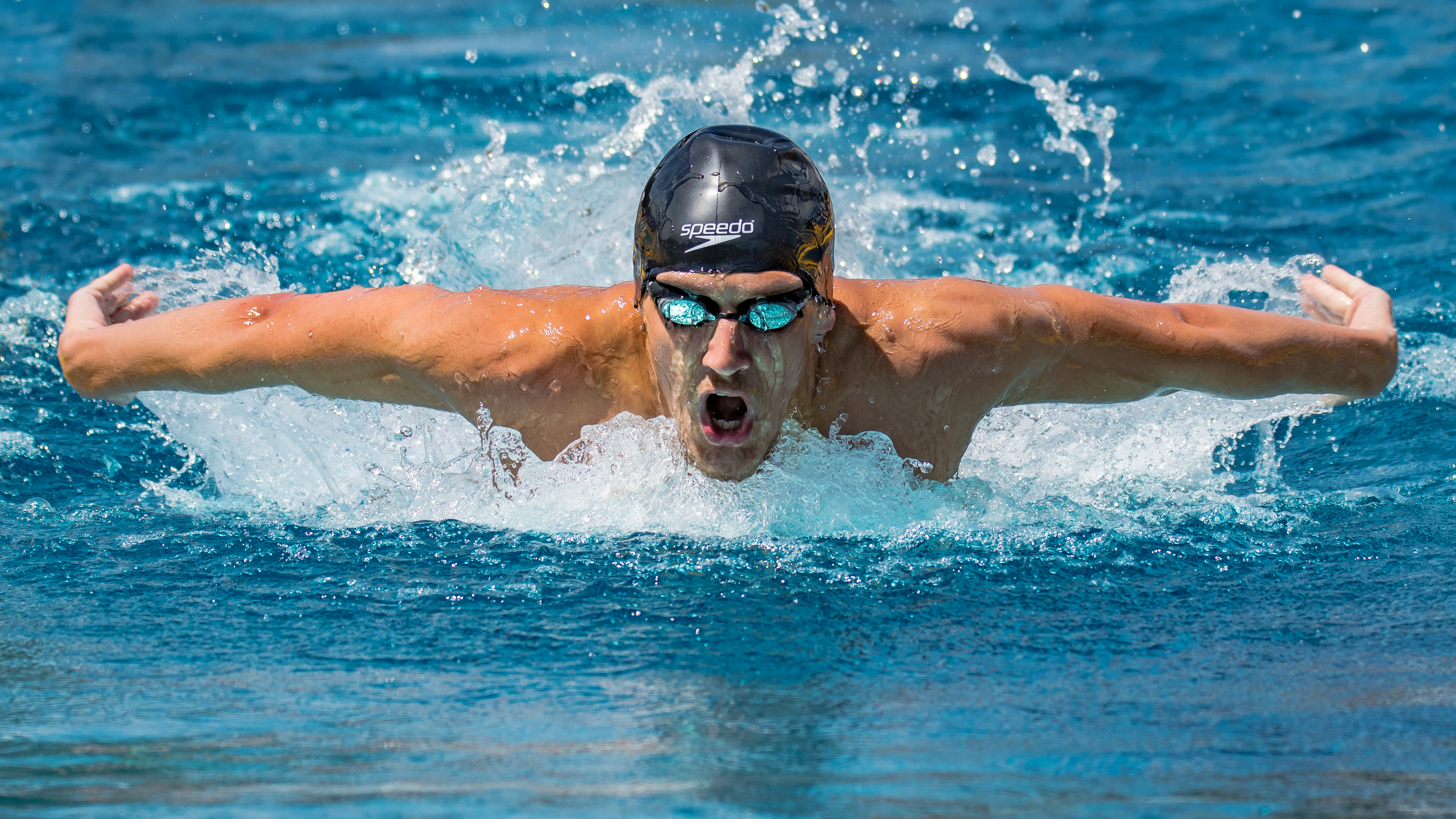|
Dolphin Kick
The dolphin kick is a kicking movement used in swimming. It is frequently used by competitive swimmers during entry and turns, and as part of the butterfly stroke. Description The dolphin kick is named for its resemblance to the motions made by a swimming dolphin. It is typically used in Swimming (sport), competitive swimming immediately after a swimmer enters the water or after turns. The swimmer performs the kick by moving both legs together, vertically, which sends a wave through the swimmer's body, propelling them forward. The stroke is useful in competitive swimming for its physical properties: it reduces Drag (physics), drag while providing a significant amount of thrust, with comparatively low physical exertion. In competitive breaststroke swimming, a single dolphin kick is allowed before the breaststroke pullout at the start and each turn, and it must be performed before the first breaststroke kick. This kick should occur after the swimmer leaves the wall and before the ... [...More Info...] [...Related Items...] OR: [Wikipedia] [Google] [Baidu] |
Swimming
Swimming is the self-propulsion of a person through water, such as saltwater or freshwater environments, usually for recreation, sport, exercise, or survival. Swimmers achieve locomotion by coordinating limb and body movements to achieve hydrodynamic thrust that results in directional motion. Newborns can instinctively hold their breath underwater and exhibit rudimentary swimming movements as part of a survival reflex. Swimming requires endurance, skill and efficient techniques to maximize speed and minimize energy consumption. Swimming is a popular activity and competitive sport where certain techniques are deployed to move through water. It offers numerous health benefits, such as strengthened circulatory system, cardiovascular health, muscle strength, and increased flexibility. It is suitable for people of all ages and fitness levels. Swimming is consistently among the top public recreational activities, and in some countries, swimming lessons are a compulsory part of the edu ... [...More Info...] [...Related Items...] OR: [Wikipedia] [Google] [Baidu] |
Butterfly Stroke
The butterfly (shortened to fly) is a List of swimming styles, swimming stroke swum on the chest, with both arms moving symmetrically, accompanied by the butterfly kick (also known as the "dolphin kick") along with the movement of the hips and chest. It is the newest swimming (sport), swimming style swum in competition, first swum in the early 1930s and originating out of the breaststroke. Speed and ergonomics The butterfly stroke boasts a higher peak velocity than the front crawl, owing to the synchronous propulsion generated by the simultaneous pull/push of both arms and legs. However, due to the pronounced drop in speed during the recovery phase, it is marginally slower than the front crawl, especially over extended distances. Furthermore, the butterfly stroke demands a different level of physical exertion, contributing to its slower overall pace than the front crawl. Butterfly stroke without text.gif Butterfly stroke3 without text.gif History of the butterfly stroke ... [...More Info...] [...Related Items...] OR: [Wikipedia] [Google] [Baidu] |
Dolphin
A dolphin is an aquatic mammal in the cetacean clade Odontoceti (toothed whale). Dolphins belong to the families Delphinidae (the oceanic dolphins), Platanistidae (the Indian river dolphins), Iniidae (the New World river dolphins), Pontoporiidae (the brackish dolphins), and possibly extinct Lipotidae (baiji or Chinese river dolphin). There are 40 extant species named as dolphins. Dolphins range in size from the and Maui's dolphin to the and orca. Various species of dolphins exhibit sexual dimorphism where the males are larger than females. They have streamlined bodies and two limbs that are modified into flippers. Though not quite as flexible as Pinniped, seals, they are faster; some dolphins can briefly travel at speeds of or leap about . Dolphins use their conical teeth to capture fast-moving Predation, prey. They have well-developed hearing which is adapted for both air and water; it is so well developed that some can survive even if they are blind. Some species are w ... [...More Info...] [...Related Items...] OR: [Wikipedia] [Google] [Baidu] |
Swimming (sport)
Swimming is an individual or team Racing, racing sport that requires the use of one's entire body to move through water. The sport takes place in Swimming pool, pools or open water (e.g., in a sea or lake). Competitive swimming is one of the most popular Olympic sports, with varied distance events in Butterfly stroke, butterfly, backstroke, breaststroke, Freestyle swimming, freestyle, and individual medley. In addition to these individual events, four swimmers can take part in either a freestyle or medley Relay race, relay. A medley relay consists of four swimmers who will each swim a different stroke, ordered as backstroke, breaststroke, butterfly and freestyle. Swimming each stroke requires a set of specific techniques; in competition, there are distinct regulations concerning the acceptable form for each individual stroke. There are also regulations on what types of swimsuits, caps, jewelry and injury tape that are allowed at competitions. There are many health benefits to ... [...More Info...] [...Related Items...] OR: [Wikipedia] [Google] [Baidu] |
Drag (physics)
In fluid dynamics, drag, sometimes referred to as fluid resistance, is a force acting opposite to the direction of motion of any object moving with respect to a surrounding fluid. This can exist between two fluid layers, two solid surfaces, or between a fluid and a solid surface. Drag forces tend to decrease fluid velocity relative to the solid object in the fluid's path. Unlike other resistive forces, drag force depends on velocity. Drag force is proportional to the relative velocity for low-speed flow and is proportional to the velocity squared for high-speed flow. This distinction between low and high-speed flow is measured by the Reynolds number. Drag is instantaneously related to vorticity dynamics through the Josephson-Anderson relation. Examples Examples of drag include: * Net force, Net Aerodynamic force, aerodynamic or Fluid dynamics, hydrodynamic force: Drag acting opposite to the direction of movement of a solid object such as cars, aircraft, and boat hulls. * Viscou ... [...More Info...] [...Related Items...] OR: [Wikipedia] [Google] [Baidu] |
Thrust
Thrust is a reaction force described quantitatively by Newton's third law. When a system expels or accelerates mass in one direction, the accelerated mass will cause a force of equal magnitude but opposite direction to be applied to that system. The force applied on a surface in a direction perpendicular or normal to the surface is also called thrust. Force, and thus thrust, is measured using the International System of Units (SI) in newtons (symbol: N), and represents the amount needed to accelerate 1 kilogram of mass at the rate of 1 meter per second per second. In mechanical engineering, force orthogonal to the main load (such as in parallel helical gears) is referred to as static thrust. Examples A fixed-wing aircraft propulsion system generates forward thrust when air is pushed in the direction opposite to flight. This can be done by different means such as the spinning blades of a propeller, the propelling jet of a jet engine, or by ejecting hot gases f ... [...More Info...] [...Related Items...] OR: [Wikipedia] [Google] [Baidu] |
Breaststroke
Breaststroke is a human swimming, swimming style in which the swimmer is on their chest and the torso does not rotate. It is the most popular recreational style due to the swimmer's head being out of the water a large portion of the time, and that it can be swum comfortably at slow speeds. In most swimming classes, beginners learn either the breaststroke or the freestyle (front crawl) first. However, at the competitive level, swimming breaststroke at speed requires endurance and strength comparable to other strokes. Some people refer to breaststroke as the "frog" stroke, as the arms and legs move somewhat like a frog swimming in the water. The stroke itself is the slowest of any competitive strokes and is thought to be the oldest of all swimming strokes. Speed and ergonomics Breaststroke is the slowest of the four official styles in swimming (sport), competitive swimming. The fastest breaststrokers can swim about 1.70 meters (~5.6 feet) per second. It is sometimes the harde ... [...More Info...] [...Related Items...] OR: [Wikipedia] [Google] [Baidu] |
1988 Olympics
1988 Olympics refers to both: *The 1988 Winter Olympics, which were held in Calgary, Alberta, Canada *The 1988 Summer Olympics The 1988 Summer Olympics (), officially the Games of the XXIV Olympiad () and officially branded as Seoul 1988 (), were an international multi-sport event held from 17 September to 2 October 1988 in Seoul, South Korea. 159 nations were represe ..., which were held in Seoul, South Korea {{Short pages monitor ... [...More Info...] [...Related Items...] OR: [Wikipedia] [Google] [Baidu] |
World Aquatics
World Aquatics, formerly known as FINA (; ), is the international federation recognised by the International Olympic Committee (IOC) for administering international competitions in List of water sports, water sports. It is one of several international federations which administer a given sport or discipline for both the IOC and the international community. It is based in Lausanne, Lausanne, Switzerland. Founded as FINA (; ) in 1908, the federation was officially renamed World Aquatics in January 2023. World Aquatics currently oversees competition in six aquatics sports: Swimming (sport), swimming, Diving (sport), diving, high diving, Synchronised swimming, artistic swimming, water polo, and open water swimming. from the FINA website (www.fina.org); retrieved 2013-06-05. World Aquatics also oversees "Masters swimming, Masters" competition (for adults) in its disciplines. History FINA was founded on 19 July 1908 in the Manchester Hotel in London, at the end of the 1908 Summer ... [...More Info...] [...Related Items...] OR: [Wikipedia] [Google] [Baidu] |
Swimming World News
} ''Swimming World'' is a US-based quarterly swimming magazine that was first published in a magazine format as ''Junior Swimmer'' in January 1960. It concurrently runs online websites ''Swimming World Magazine'' and ''Swimming World News'' (known as ''SwimInfo'' prior to 2006). History In its earliest form, ''Junior Swimmer'' began as a mimeograph/newsletter published by Peter Daland in the summer of 1952. In 1960, Coach Daland passed the responsibility of the project to Albert Schoenfeld due to Daland's greater coaching demands as the swim coach at the University of Southern California and the Los Angeles Athletic Club. The January 1960 issue was the first published in a magazine format, still called ''Junior Swimmer''. The magazine then went through six title changes over the next 45 years. In May 1961, the magazine changed its main cover title to ''Jr./Sr. Swimmer''. The publication then combined with ''Swimming World'' in June 1961. At that time, ''Swimming World'' was s ... [...More Info...] [...Related Items...] OR: [Wikipedia] [Google] [Baidu] |
Popular Science
Popular science (also called pop-science or popsci) is an interpretation of science intended for a general audience. While science journalism focuses on recent scientific developments, popular science is more broad ranging. It may be written by professional science journalists or by scientists themselves. It is presented in many forms, including books, film and television documentaries, magazine articles, and web pages. History Before the modern specialization and professionalization of science, there was often little distinction between "science" and "popular science", and works intended to share scientific knowledge with a general reader existed as far back as Greek and Roman antiquity. Without these popular works, much of the scientific knowledge of the era might have been lost. For example, none of the original works of the Greek astronomer Eudoxus (4th century BC) have survived, but his contributions were largely preserved due to the didactic poem '' Phenomena'' writte ... [...More Info...] [...Related Items...] OR: [Wikipedia] [Google] [Baidu] |







